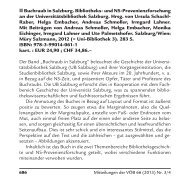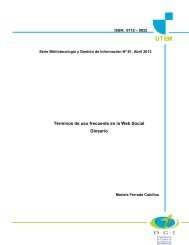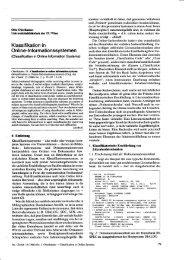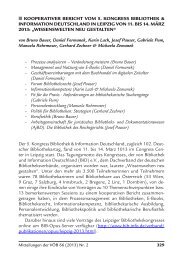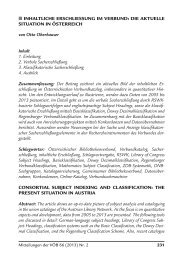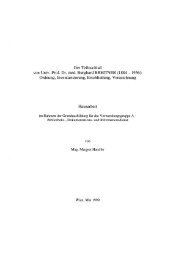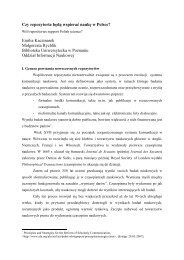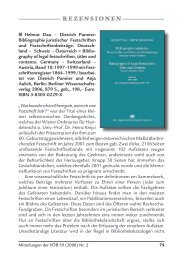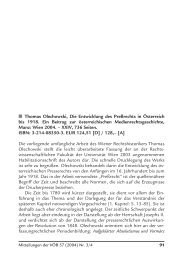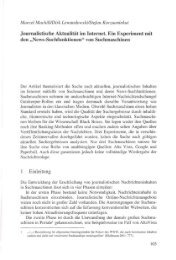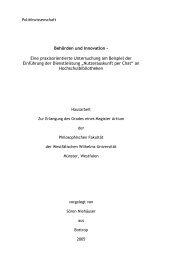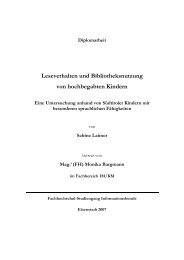Informationsanalyse in Theorie und Praxis am Beispiel eines ... - E-LIS
Informationsanalyse in Theorie und Praxis am Beispiel eines ... - E-LIS
Informationsanalyse in Theorie und Praxis am Beispiel eines ... - E-LIS
Erfolgreiche ePaper selbst erstellen
Machen Sie aus Ihren PDF Publikationen ein blätterbares Flipbook mit unserer einzigartigen Google optimierten e-Paper Software.
Ch. Scharaditsch FHS Informationsberufe 2008<br />
2.4.3 Elemente e<strong>in</strong>es <strong>in</strong>tegrierten Informationsmanagements<br />
Herget (2004, S. 245) beschreibt Informationsmanagement als „…tragfähiges <strong>und</strong><br />
zukunftsweisendes Konzept“, das seit etwa 1980 immer mehr an Bedeutung gewonnen<br />
hat. Es gibt unterschiedliche Zus<strong>am</strong>menhänge, <strong>in</strong> denen sich das<br />
Informationsmanagement entwickelt hat. Die Auslöser hierbei waren jedoch immer<br />
die gleichen, wie z.B. die Entwicklung von Informationstechnologien <strong>und</strong> Medien<br />
<strong>und</strong> die Globalisierung der Märkte, wodurch auch der Informations- <strong>und</strong><br />
Kommunikationsbedarf gestiegen ist. Als weiterer Faktor ist auch das moderne<br />
Management zu nennen, durch das sich die Kultur der Information <strong>und</strong><br />
Kommunikation <strong>in</strong> Unternehmen <strong>und</strong> die Ausbildung der Mitarbeiter, die nun<br />
spezifischere Informations- <strong>und</strong> Kommunikationsbedürfnisse haben, verändert hat.<br />
Produkte <strong>und</strong> Dienstleistungen s<strong>in</strong>d <strong>in</strong>formations- <strong>und</strong> wissens<strong>in</strong>tensiver als d<strong>am</strong>als.<br />
Deshalb wurde das Management von Information <strong>und</strong> Wissen zum Schlüsselfaktor<br />
des Erfolges e<strong>in</strong>es Unternehmens. (Herget, 2004, S. 245)<br />
Es greift somit <strong>in</strong> alle nachfolgend beschriebenen Phasen des Informationslebenszyklus<br />
e<strong>in</strong> (Herget, 2004, Seite 248):<br />
• Informationsbedarf bestimmen (Welche Informationen benötigt das Unternehmen?),<br />
• <strong>in</strong>terne <strong>und</strong> externe Informationen beschaffen <strong>und</strong> suchen,<br />
• Informationsressourcen erschließen <strong>und</strong> organisieren,<br />
• Informationsgüter produzieren (Informationsprodukte herstellen, aufbereiten<br />
<strong>und</strong> als Informationssysteme oder –dienst anbieten),<br />
• Distribution von Informationsgütern (Zugriff auf Informationsprodukte <strong>und</strong> –<br />
dienste – wer, wo),<br />
• zur Verfügung stehende Informationen nutzen <strong>und</strong> verwerten (Informationssensibilität<br />
fördern, Informationsbarrieren abbauen, Nutzung wenn nötig verbessern),<br />
• Organisation des ges<strong>am</strong>ten Prozesses der Informationsversorgung (optimierte<br />
Zielerreichung durch Informationsarbeit).<br />
Herget (2004, S. 249-252) nennt sechs Elemente, aus denen e<strong>in</strong> <strong>in</strong>tegriertes Informationsmanagement<br />
bestehen soll (Ziele <strong>und</strong> Strategien der Organisation, In-<br />
- 12 -



